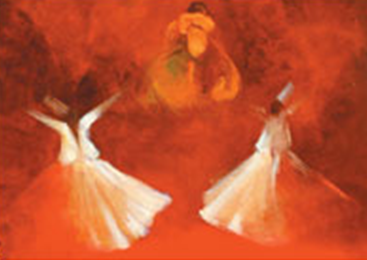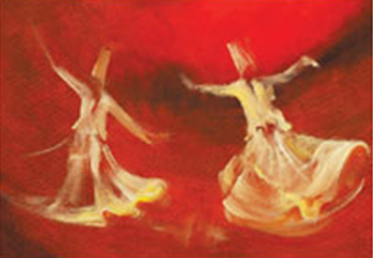Shafique Farooqi
This is a collection of articles archived for the excellence of their content. Readers will be able to edit existing articles and post new articles directly |
Shafique Farooqi
A spiritual expression
By Fahad Rahman
Like a ghostly figure hovering in mid-air, mingling with the hues and shades of the seven skies, the whirling dervaish puts the observer in a state of contemplative meditation. Shafique Farooqi’s latest exhibition of oil paintings of whirling dervaish recently held at Hamail Art Galleries in Lahore too had a magnetic effect on the viewers as it spoke to them at a deep, spiritual level. Shafique has spent more than a decade in Turkey, where the whirling dervaish have swirled and performed for centuries. He has spent time observing and interacting with the dervaish and has been greatly inspired by them to bring interpretation of this phenomenon on his canvas.
Shafique Farooqi is a spiritual man and believes in expressing his religious beliefs. He sees the spiritual dimension and forces in his work as well as his life. Even this exhibition according to him had a layer of religious intervention involved. “Everyone told me to cancel the exhibition as it was extremely hot in Lahore and no one wants to visit art galleries in such weather. But I had an intuitive feeling that I should go ahead with it. As it turned out, by the grace of God, the weather changed significantly and became much more bearable!” he said dramatically. The significance and meaning behind his paintings has to be analysed keeping this spiritual dimension in mind drawing inferences from the various forms and techniques he uses.
The whirling dervaish are spiritually influenced by their famous founder Maulana Jalaluddin Rumi (1207-1273), a literary master who was a poet, a philosopher and a Sufi mystic. From this spinning arose a mode of spiritual expression that exists even today and continues to enthral and mystify mankind. As the whirling dervaish spins he gradually loses consciousness of this world and reality and transcends to another realm. The spinning dervaish communicates with the Creator and loses all of his sense of individuality.
Shafique takes this emblematic and famous form of artistic expression as the theme of his own artistic expression. The paintings have fundamental aspects of Islamic art, like a vague representation of human figures. The whirling dervaish may be spinning in the paintings, but they do not have defined faces or expressions. The boundaries of the figures and the background intermingle and form blurry outlines. The arms and legs extend and fade away with the surrounding colours. Thus, the eyes behold the figure of the whirling dervaish while never really seeing a concrete individual with expressions of its own. The paintings show the dervaish floating or hovering and not firmly entrenched on any ground. This represents how the experience of the whirling dervaish dance is supposed to be transcendental where the dervaish is lifted above the mundane ground to the sacred ecstatic realms of the holy. In some of the paintings we see an interesting play with light, showing a light beam emerging from the skies, falling on the hovering and spinning dervaish and then reaching the ground. The grace and existence of God in the spiritual practice of the dervaish is acknowledged and represented by this beam of light.
The message Shafique wants to deliver through these paintings is influenced by Sufi thought: This world is a transitory affair and one should not form attachments with the worldly. The ultimate aim is to merge with the holy and become transcendent. “The dervaish is a great example of a model human being as he does not struggle for worldly gains, but instead demonstrates a harmony and balance in temperament. This can only be achieved when one lives a simple life with the sole purpose of moving closer to God,” he explains.
This series of paintings also offers a statement about the extremist tendency to condemn all such forms of religious expressions. Shafique supports all forms of religious expressions as long as the intent is to remember and venerate God. “We are free to do what we want to do. As long as we don’t violate any clearly stated Islamic injunction we should be relaxed about religious expressions,” he opines.
As one beholds the whirling dervaish in Shafique’s paintings, one is struck by the emotional aspect that these paintings elicit. The play of colour and form leaves us with a feeling of divine mystery and a serene harmony. Shafique has learned and taught colour psychology and knows exactly how the different colours affect subjectivity and feelings.
The artist, who has 85 solo exhibitions to his credit along with 20 awards and 15 honours from Pakistan and abroad, has always expressed his deepest convictions and beliefs in his art-work. This latest series of paintings is once again an attempt at bringing to the consciousness certain aspects of our own identity that may have been dormant. After spending many years immersed in the milieu of the contemporary whirling dervaish, the art produced stems from deep understanding and commitment. The paintings are not superficial renditions of the whirling dervaish but a tribute to a phenomenon that the artist clearly feels a personal connection with. According to Shafique, commercial production of aesthetically appealing images is not art, instead, art requires a very unique mix of talent, hard-work and personality. “The artist lies somewhere between the angels and the ordinary mortals!” is a common saying in Turkey and Shafique demonstrates this by the sensitivity required in painting scenes that arouse our spirituality and elicit a sense of serenity within the beholder.




